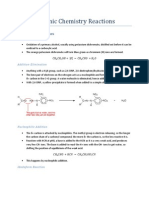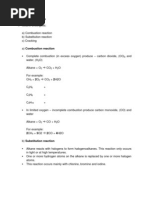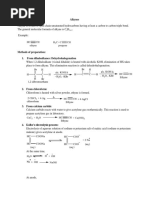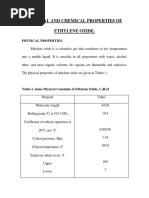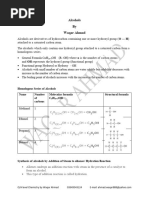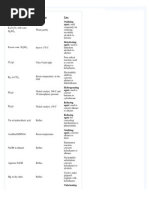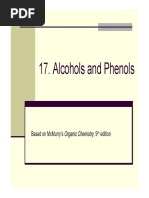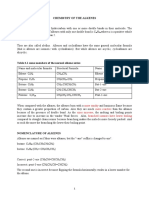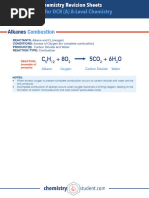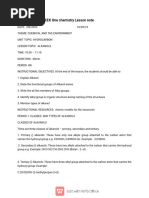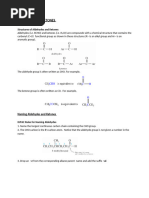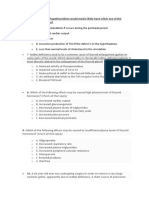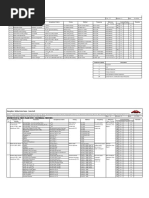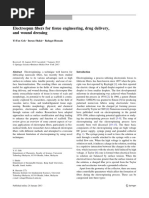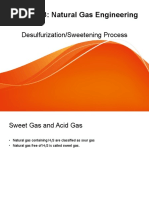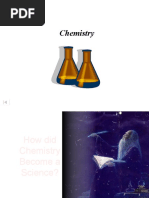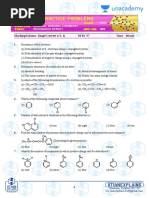Organic Compound Reagent/reactant Condition Classification
Organic Compound Reagent/reactant Condition Classification
Uploaded by
FaridOrahaCopyright:
Available Formats
Organic Compound Reagent/reactant Condition Classification
Organic Compound Reagent/reactant Condition Classification
Uploaded by
FaridOrahaOriginal Description:
Original Title
Copyright
Available Formats
Share this document
Did you find this document useful?
Is this content inappropriate?
Copyright:
Available Formats
Organic Compound Reagent/reactant Condition Classification
Organic Compound Reagent/reactant Condition Classification
Uploaded by
FaridOrahaCopyright:
Available Formats
Organic
compound
Alkane
Reagent/reactant
Condition
Classification
O2
In gaseous state
Combustion,produces water &
CO2
Sunlight, organic solvent
Homolytic free radical
substitution,produces
halogenoalkanes
Nickel cat, 4atm,
100<suo>o</sup>C
Heterolytic eletrophilic
addition,produces alkanes
Cl2, Br2, I2
Aqueous or organic,
reaction with Br water used
to test for alkenes
Heterolytic eletrophilic
addition,produces RX with 2
halogen atoms
HCl, HBr, HI
Gas phase or inert/organic
solvent
Heterolytic eletrophilic
addition,markovnikovs rule,
cabocation stability,produces RX
KMnO4 , acidified
potassium mangnate
(VII)
Purple colour of solution
decolorises when added to
alkenes.
Oxidation, heterolytic
eletrophilic addition,produces
diols
Phosphoric acid
H3PO4 cat
300oC, 60atm, ethanol the
reaction is reversible and
yield is 95% as unused
gases are recycled.
Hetrolytic electrophilic
addition.,steam hydration
produces ethanol
Alkene
Oxygen containing
compound to initiate
reaction. Ethene
polymerises to low density
polyethene at 200 oC and
20000atm.
Addition Polymerisation
H2SO4 and water.
The H2SO4 acts as a
catalyst and is recovered in
the end when water reacts
with alkyl hydrogen
sulphates to produce ROH
Electrophilic addition reaction
Warm, aqueous under
reflux
Heterolytic nucleophilic
substitution, RX hydrolysed to
ROH nu- is OH-, iodoalkanes
are fastest to hydrolyse because
their bonds are the weakest.
KOH
Warm in ethanol, in
anhydrous conditions and
under reflux
Elimination, produces alkenes
and KX
KCN
Ethanol, under reflux this
Heterolytic nucleophilic
produces nitriles, nu- is CN- substitution,this produces -
NH3
NH3 is dissolved in ethanol,
heated under reflux.
Heterolytic nucleophilic
substitution, this produces
amines.
For 1mary RX under reflux
for ROOH production,
distillation for aldehydes
Oxidation, for primary
secondary but tertiary ROH
cant be oxidised.
Cl2, Br2, I2
Alkene
H2
RCl, RBr, RI
Haloalkanes KOH, NAOH
ROH,
Alcohols
K2Cr2O72-/H+
acidified potassium
dichromate(VI)
For 2ndry ROH under reflux
for ketones
H2SO4(l)
Reflux at 170oC
Dehydration produces c=c
Al2O3(s)
300oC
Dehydration produces c=c
H3PO3
70oC
Dehydration produces c=c
PCl5(l)
Room temp used to test for
OH group when added to
OH acidic fumes produced
turning blue litmus paper
red
Halogenation,produces
chloroalkanes
NaBr(s)/H2SO4(l)
Reflux, HBR is made in situ
from sulphuric acid and NBr
Halogenation produces
bromoalaknes, nucleophilic
substitution
Red P + I2
Reflux
Halogenation produces
iodoalkanes
Na metal
Na will react gently with
ROH
This produces alkoxides such as
sodium ethanoate and H gas
ROOH
Warm with a conc acid
catalyst
This produces esters the O-H
bond is broken in the
Esterification reaction
You might also like
- Harder SUVATDocument2 pagesHarder SUVATFaridOraha50% (2)
- Unit 4 Organic Chemistry ReactionsDocument6 pagesUnit 4 Organic Chemistry ReactionsRobbing_Hood100% (1)
- CHM 121 Lecture NoteDocument13 pagesCHM 121 Lecture NoteOyedotun TundeNo ratings yet
- Alkene 2Document16 pagesAlkene 2Nadzirah YusopNo ratings yet
- 16 Hydroxyl compound-24-STDDocument38 pages16 Hydroxyl compound-24-STDManh Doan DucNo ratings yet
- Chap 8 LDocument127 pagesChap 8 Lxp4gb45jjqNo ratings yet
- Carbonyl Compounds Aldehydes KetonesDocument58 pagesCarbonyl Compounds Aldehydes KetonesNur Aliyah Abdul RazakNo ratings yet
- Aldehydes and KetonesDocument4 pagesAldehydes and Ketonesnvmohankumar85No ratings yet
- Alkynes 1Document4 pagesAlkynes 1Prazwal RegmiNo ratings yet
- Aldehydes, Ketones and Carboxylic AcidDocument19 pagesAldehydes, Ketones and Carboxylic AcidPraneel BhattNo ratings yet
- Reaction Notes For Organic ChemistryDocument11 pagesReaction Notes For Organic ChemistryTyler Lawrence CoyeNo ratings yet
- Ethylene-2520oxide Properties&uses PDFDocument6 pagesEthylene-2520oxide Properties&uses PDFaffeenaNo ratings yet
- 12.3 Aldehydes, Ketones and Carboxlic Acids - Chemical PropertiesDocument16 pages12.3 Aldehydes, Ketones and Carboxlic Acids - Chemical Propertieshotgirlie1234No ratings yet
- Organic Chemistry Reactions For H2 Chemistry, A-LevelsDocument4 pagesOrganic Chemistry Reactions For H2 Chemistry, A-LevelsJin WenRui ShaunNo ratings yet
- AlcoholsDocument5 pagesAlcoholsbluedaddy8No ratings yet
- Reactions CIEDocument26 pagesReactions CIEdenithmayon1No ratings yet
- Aldehydes and KetonesDocument8 pagesAldehydes and Ketonespromisegabrielpepple2004No ratings yet
- Aldehydes & KetonesDocument104 pagesAldehydes & KetonesCharin Kadian83% (6)
- Aldehydes, Ketones and Carboxylic Acids 24-25 KVDocument20 pagesAldehydes, Ketones and Carboxylic Acids 24-25 KVMohammad PalekarNo ratings yet
- Name of Reagent Conditions Uses Oxidising Agent, UsedDocument2 pagesName of Reagent Conditions Uses Oxidising Agent, UsedFsdhdf FbxhNo ratings yet
- Hydrocarbon NotesDocument7 pagesHydrocarbon Notesl8627352No ratings yet
- Aldehydes and Ketones - Notes-12Document11 pagesAldehydes and Ketones - Notes-12Shashank ParthibanNo ratings yet
- Aldehydes and KetonesDocument11 pagesAldehydes and Ketonesshahramfatah5No ratings yet
- Summary of Organic ReactionsDocument3 pagesSummary of Organic ReactionsDhruba FahimNo ratings yet
- Aldehydes, Ketones and Carboxylic AcidsDocument17 pagesAldehydes, Ketones and Carboxylic AcidsSohamNo ratings yet
- Carbonyl CompoundsDocument40 pagesCarbonyl CompoundsMiguelNo ratings yet
- Alcohols and Phenols: Based On Mcmurry'S Organic Chemistry, 9 EditionDocument47 pagesAlcohols and Phenols: Based On Mcmurry'S Organic Chemistry, 9 Edition劉靖騰No ratings yet
- Organic Chemistry 2 PDFDocument15 pagesOrganic Chemistry 2 PDFEnica RichardNo ratings yet
- Reactions AQADocument35 pagesReactions AQAEdcademiaNo ratings yet
- Alkenes and AlkynesDocument22 pagesAlkenes and AlkynesAyodele AdeyonuNo ratings yet
- Alchohols Phenols and EthersDocument5 pagesAlchohols Phenols and EthersPritika Yamini SaiNo ratings yet
- Alcohols NotesDocument4 pagesAlcohols Notesjohn mNo ratings yet
- Chapter 17Document64 pagesChapter 17님킹디No ratings yet
- Aldehydes, Ketones & Carboxylic AcidsDocument19 pagesAldehydes, Ketones & Carboxylic Acidsmdevdharshan07No ratings yet
- ReactionsOCR 2Document35 pagesReactionsOCR 2Ali AfaqNo ratings yet
- F334 - What's in A Medicine?Document11 pagesF334 - What's in A Medicine?Becky Tenney100% (1)
- Chemistry of The Alcohols Alcohols: Monohydric C H OHDocument23 pagesChemistry of The Alcohols Alcohols: Monohydric C H OHAyodele AdeyonuNo ratings yet
- Edexcel & Cambridge Syllabus: Unit 4: Carbonyl Compounds Alauddin Sir A & O Level Chemistry TeacherDocument8 pagesEdexcel & Cambridge Syllabus: Unit 4: Carbonyl Compounds Alauddin Sir A & O Level Chemistry TeacherMaliha Ishrat JarinNo ratings yet
- Alcohols 1Document13 pagesAlcohols 1Suresh VedpathakNo ratings yet
- Organic ChemistryDocument13 pagesOrganic ChemistryTazrin BibortonNo ratings yet
- Haloalkanes Class 12 Complete Notes.Document96 pagesHaloalkanes Class 12 Complete Notes.rakmoomkargoluNo ratings yet
- HSSRPTR - Aldehyde, Ketones and Acids HSS +2Document14 pagesHSSRPTR - Aldehyde, Ketones and Acids HSS +2spinjitzulastnameNo ratings yet
- SS 2 A, B and C WEEK One Chemistry Lesson NoteDocument5 pagesSS 2 A, B and C WEEK One Chemistry Lesson Notebilldanit4fitzNo ratings yet
- Carbonyl CompoundsDocument5 pagesCarbonyl Compoundssstamiljeevan17012008No ratings yet
- O R C H O R C R: Carbonyl Compounds (Aldehydes and Ketones)Document10 pagesO R C H O R C R: Carbonyl Compounds (Aldehydes and Ketones)Fakin AsholNo ratings yet
- The Hydrogenation of AlkenesDocument8 pagesThe Hydrogenation of AlkenesMuhamad Nazrul BoyoteenNo ratings yet
- Carbonyl Compound-2Document20 pagesCarbonyl Compound-2fishindasea00No ratings yet
- ALDEHYDES-AND-KETONES_120942Document14 pagesALDEHYDES-AND-KETONES_120942mamailao.rahmaNo ratings yet
- 1Document6 pages170123No ratings yet
- Bayer Test, Dan Bromine TestDocument18 pagesBayer Test, Dan Bromine TestBa'ist KhaerulNo ratings yet
- 6 AcidDocument22 pages6 AcidhaslimiNo ratings yet
- SS2 HydroCarbonDocument35 pagesSS2 HydroCarbonnou242320058No ratings yet
- Homologous Series MembersDocument22 pagesHomologous Series MembersCleisaxolocolvtwo AndersonNo ratings yet
- Chemistry Form 6 Sem 3 04Document44 pagesChemistry Form 6 Sem 3 04Ng Swee Loong StevenNo ratings yet
- EP101 Sen LNT 008 Ketone&Aldehyde May11Document18 pagesEP101 Sen LNT 008 Ketone&Aldehyde May11Sàtz ÑÖÑïtNo ratings yet
- CHEM 4113 Organic Chemistry Ii Lecture Notes: Eq - 5 Eq - 7Document9 pagesCHEM 4113 Organic Chemistry Ii Lecture Notes: Eq - 5 Eq - 7Kuandi TanNo ratings yet
- Aldehydes, Ketones and Carboxylic AcidsDocument81 pagesAldehydes, Ketones and Carboxylic AcidsprateekshadharaniNo ratings yet
- Organic Flow Chart 16Document3 pagesOrganic Flow Chart 16Kshitiz JoshiNo ratings yet
- Presentation of Group (A)Document65 pagesPresentation of Group (A)alihaiderengr78670No ratings yet
- Practice Makes Perfect in Chemistry: Acids, Bases, and Salts with AnswersFrom EverandPractice Makes Perfect in Chemistry: Acids, Bases, and Salts with AnswersNo ratings yet
- Unit Title: Introduction To Travel and Tourism Level: Entry 3 Credit Value: 1 GLH: 10 Unit Code: HC4/E3/NQ/085 QCF Unit Reference Number: A/504/9877Document2 pagesUnit Title: Introduction To Travel and Tourism Level: Entry 3 Credit Value: 1 GLH: 10 Unit Code: HC4/E3/NQ/085 QCF Unit Reference Number: A/504/9877FaridOrahaNo ratings yet
- Seams InstructionsDocument1 pageSeams InstructionsFaridOrahaNo ratings yet
- 2009 Unit 1 ISA Question PaperDocument2 pages2009 Unit 1 ISA Question PaperFaridOrahaNo ratings yet
- Epidemiology of Melanoma Malignant Melanoma: DescriptionDocument5 pagesEpidemiology of Melanoma Malignant Melanoma: DescriptionFaridOrahaNo ratings yet
- External MCQDocument4 pagesExternal MCQFaridOrahaNo ratings yet
- MCQ ThyroidDocument6 pagesMCQ ThyroidFaridOrahaNo ratings yet
- Safety Rules MasterDocument2 pagesSafety Rules MasterFaridOrahaNo ratings yet
- Introduction To Travel & Tourism - Unit 1: StarterDocument3 pagesIntroduction To Travel & Tourism - Unit 1: StarterFaridOrahaNo ratings yet
- Holiday Year 7 ArabicDocument38 pagesHoliday Year 7 ArabicFaridOrahaNo ratings yet
- SUVAT QuestionsDocument1 pageSUVAT QuestionsFaridOrahaNo ratings yet
- Spanish Specemen 4482Document65 pagesSpanish Specemen 4482FaridOrahaNo ratings yet
- Structure Determination QuestionsDocument18 pagesStructure Determination QuestionsFaridOrahaNo ratings yet
- Aortic Valve DiseaseDocument63 pagesAortic Valve DiseaseFaridOrahaNo ratings yet
- Access To Assessment Tracking SheetDocument1 pageAccess To Assessment Tracking SheetFaridOrahaNo ratings yet
- ST - Xavier KannaujDocument13 pagesST - Xavier KannaujdivyanshkannaujiaNo ratings yet
- Class 12 Electrochemistry QuestionsDocument4 pagesClass 12 Electrochemistry QuestionsShifaNo ratings yet
- Full Report Carbs On 161.1Document23 pagesFull Report Carbs On 161.1Kim Leonard BolandosNo ratings yet
- Decomposition of Human RemainsDocument23 pagesDecomposition of Human RemainsnmnkjNo ratings yet
- Inspection & Test Plan (Itp) : PilingDocument3 pagesInspection & Test Plan (Itp) : PilingLOPA THANDARNo ratings yet
- Poultry: Professional Products For The Poultry IndustryDocument1 pagePoultry: Professional Products For The Poultry IndustryzoilaNo ratings yet
- PET Fibers, Films, and Bottles: V. B. Gupta, Z. BashirDocument45 pagesPET Fibers, Films, and Bottles: V. B. Gupta, Z. BashirAryan KumarNo ratings yet
- Classification and Properties of Materials: Humayun Kabir, Lecturer, Dept. of MMEDocument27 pagesClassification and Properties of Materials: Humayun Kabir, Lecturer, Dept. of MMEBiddut DasNo ratings yet
- Mock Boards Module 1Document15 pagesMock Boards Module 1Renesmae GonzagaNo ratings yet
- 14 Year 13 Chemistry Paper 2 QP ABDocument13 pages14 Year 13 Chemistry Paper 2 QP ABlaukkeasNo ratings yet
- Experiment No. 5: The Preparation of Barium PeroxideDocument7 pagesExperiment No. 5: The Preparation of Barium PeroxideKarzanNo ratings yet
- SECTION 03 52 00 Lightweight Concrete Roof InsulationDocument7 pagesSECTION 03 52 00 Lightweight Concrete Roof InsulationJuanPaoloYbañezNo ratings yet
- Monomer For Polymer SynthesisDocument32 pagesMonomer For Polymer SynthesisIwan TirtaNo ratings yet
- Class 8 Science Chapter Metals and Non-MetalsDocument6 pagesClass 8 Science Chapter Metals and Non-MetalsPriyanka SrivastavaNo ratings yet
- Electrospinning Review Journal of Materials ScienceDocument28 pagesElectrospinning Review Journal of Materials ScienceeliasNo ratings yet
- VitreousDocument21 pagesVitreousezekiel eshunNo ratings yet
- 5070 w10 QP 13Document20 pages5070 w10 QP 13Hala989No ratings yet
- Bowl ChiralityDocument25 pagesBowl ChiralitylaxmanNo ratings yet
- Chlorination: Equipment and AccessoriesDocument57 pagesChlorination: Equipment and Accessoriesonizuka-t2263No ratings yet
- Preparation of Synthetic Zeolite ZSM-5Document7 pagesPreparation of Synthetic Zeolite ZSM-5Bao TranNo ratings yet
- Introduction To Fouling in Oil Refining PDFDocument2 pagesIntroduction To Fouling in Oil Refining PDFMaría Alejandra Quintero PinillaNo ratings yet
- Geopolymer A Potential Alternative Binder For The Sustainabledevelopment of Concrete Without Ordinary Portland CementDocument5 pagesGeopolymer A Potential Alternative Binder For The Sustainabledevelopment of Concrete Without Ordinary Portland Cementbamideleraheem1No ratings yet
- Alkylation Isomerization and Polymerization ProcessesDocument13 pagesAlkylation Isomerization and Polymerization Processesnavya.cogni21No ratings yet
- s3 - Sweetening ProcessDocument38 pagess3 - Sweetening ProcessMd Abid AfridiNo ratings yet
- FragmentsDocument4 pagesFragmentshanderson_chrisNo ratings yet
- 2E 3N Sci Chem BLS MYE 2017 QPDocument8 pages2E 3N Sci Chem BLS MYE 2017 QPKeerthikaa Loganathan (Bpghs)No ratings yet
- AlchemyDocument21 pagesAlchemyJoyae ChavezNo ratings yet
- Membrane Separation Processes: Reverse OsmosisDocument20 pagesMembrane Separation Processes: Reverse OsmosisSP ManjunathNo ratings yet
- Ralph WilsonDocument12 pagesRalph WilsonAGUSTINNo ratings yet
- DPP 25B Goc Resonance 1684507782845Document4 pagesDPP 25B Goc Resonance 1684507782845Aditya Kumar100% (1)

